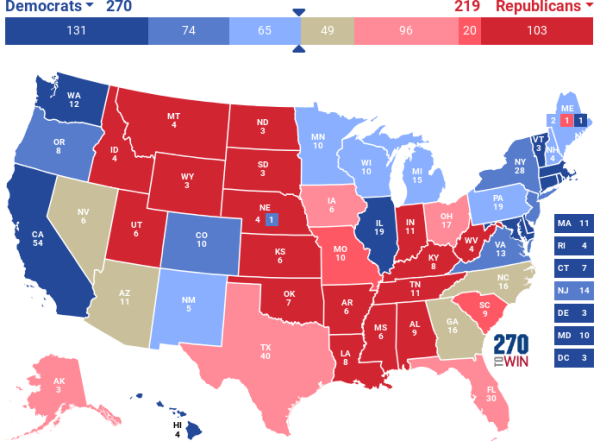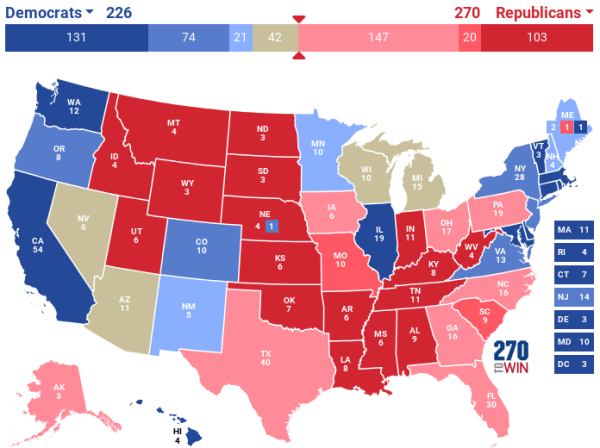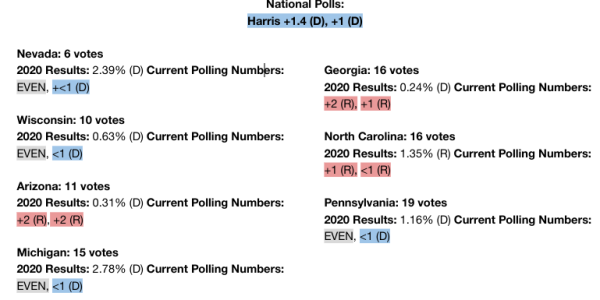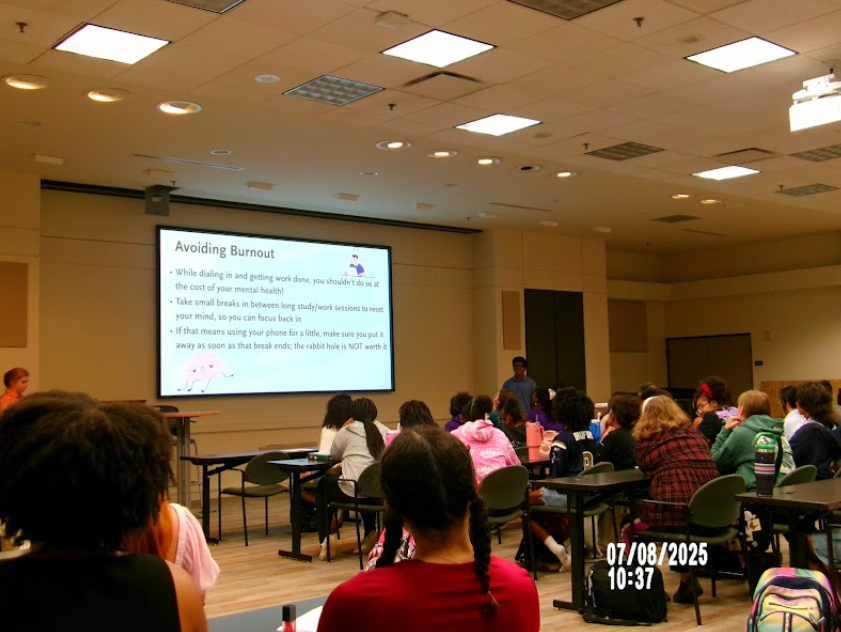Introduction
“The most important election of our lifetime,” a cliché arguably descriptive of this election, is just a week away. Whether the result will be announced on election night or in the days following, Americans will soon know who will be inaugurated on January 20. Former President Donald Trump and Vice President Kamala Harris are locked in a dead heat, a race so close that America may as well be flipping a coin to determine which of the two very different directions the country sets off in. The candidates are frantically rushing across the country, trying to highlight the strengths of their policy and prosecute a case against their opponent to convince the small part of the electorate, around 5%, that is still undecided. This article describes the policy positions of the two candidates and paints a picture of how close this crucial race will be.
The candidates’ positions on four topics on voters’ minds this election
Economy:
Harris
The Harris campaign has narrowed the polling gap with Trump on the economy, the most important issue for voters in the election, through marketing of an “opportunity economy.” This is an emphasis on small businesses (expanding start-up expense deductions from $5,000 to $50,000), banning price-gouging, and housing (building three million new homes and providing $25,000 in down payment assistance for first-time homebuyers). Carl Schramm, an economics professor at Syracuse University, says that Harris’ plans in housing would create demand before the supply could catch up: “I think it would benefit homeowners as opposed to homebuyers.” In addition, Harris wants to provide tax cuts for lower-to-middle class Americans by raising taxes on the rich and corporations.
Trump
Trump has maintained an advantage on the economy for the duration of the race, as the Biden/Harris administration’s economic policy and in particular the high inflation following the COVID pandemic has embedded itself into the minds of many Americans. Trump’s economic plan focuses on tax cuts and increased tariffs. Trump wants to extend the 2017 Tax Cuts and Jobs Act, a policy from his first term that reduces taxes for most tax brackets. On top of that, Trump wants to further reduce the corporate tax rate, which has been at 21% under TCJA to 15%, eliminate taxes on social security benefits, and institute protectionist tariff policies by creating an across the board 10-20% tariff on all foreign goods, plus a 60% tariff on goods from China. While Trump wants to use tariffs to bolster the domestic economy, economists have criticized them for passing on the costs to American consumers.
Immigration:
Trump
Stemming the flow of illegal immigration is a key part of Trump’s argument to voters; he has branded it “an invasion” that is straining social services and allowing drug dealers and potential terrorists into the country. According to Reuters, 45% of voters prefer Trump’s policy on immigration to Harris’ 37%, and it is a main motivator for his voter base. Trump says he wants to launch what would be the largest deportation operation in American history, in which he would use the U.S. military, the National Guard, and police to round up illegal immigrants and send them back to their home countries. According to USA Today, the plan is projected to cost $88 billion to deport just one million out of the 11 million illegal immigrants in the country and would face extensive legal and logistical challenges.
Harris

Since the inception of her candidacy, Harris has tried to move to the center on immigration policy to separate herself from the Biden administration on this issue. Many voters feel Biden has been weak on the border. In fact, according to The Hill, 44% of respondents believe it was his biggest failure as president. Trump has attacked Harris for her role within the Biden administration in immigration due to policies that were “too lenient,” attempting to brand her with the term “failed border czar.” Border crossings under the Biden presidency had been high compared to previous administrations for the first three years of his term, which has caused and is still causing uproar across the country, until an executive action that limited immigrants seeking asylum brought the number down to under the numbers at the beginning of Biden’s presidency. While Harris has endorsed further cracking down on asylum access and drug traffickers, she has focused on painting Trump’s policies as extreme.
Foreign Conflicts:
Harris
Overall, on the conflict in the Middle East, Harris has had to walk a tight-rope of neutrality. She has emphasized the brutality of the October 7 attacks and that she will continue to support Israel’s ability to defend itself, while in the same breath condemning human suffering in Gaza and supporting a ceasefire. While Harris appears to sympathize with the Palestinian people more than Biden, she has also not showed whether she will break stride from the previous administration’s policy, souring previous enthusiasm from pro-Palestinian activists. This attitude could have direct effects on the race. Over 100,000 people in the Democratic primary in the swing state of Michigan earlier this year voted as “uncommitted” as a protest of American military aid to Israel.
In the Russo-Ukrainian War, Harris would not shift from Biden’s policy, for she has repeatedly pledged to continue sending military and financial aid to the embattled Ukraine.
Trump

Trump is known for being one of the most pro-Israel presidents during his term, and has supported a quick end to the war in Gaza, telling Israel that they need to “get it over with.” Trump has branded himself as Israel’s protector and attacked the Biden/Harris administration, saying that “Jewish people have no excuse” to vote for the Democrats. As for Ukraine, Trump has stated that he could end the war before he became president. “What I’ll do is I’ll speak to one, I’ll speak to the other, and I’ll get them together,” he said, citing his relationship with Russian President Vladimir Putin and deal-making skills, although he hasn’t provided specific details in how he would end the war. A Trump presidency would likely come with less aid to Ukraine than there was under Biden and he would more likely recommend concessions from Ukraine when a deal is reached.
Abortion:
Trump
Abortion has been a weakness for Republicans across the board since the 2022 Dobbs v. Jackson Women’s Health Organization ruling overruled the landmark 1973 Roe v. Wade case that protected the right to an abortion. Trump has tried to moderate his position on the issue, he says that he would veto a national abortion ban and leave the decision up to the states if he was re-elected. Nonetheless, Trump has repeatedly taken credit for overturning Roe v. Wade, as it was the three justices that he appointed, Neil Gorsuch, Brett Kavanaugh, and Amy Coney Barrett, whose votes were critical in the ruling. “After 50 years of failure, with nobody coming even close, I was able to kill Roe v. Wade,” Trump said on his social media, Truth Social, last year.
Harris
“Restoring abortion rights” has become a centerpiece of the Harris campaign’s argument in 2024, which they are hoping will be a big driver of increased turnout in their favor on November 5. Harris has promised that she would sign a bill into law to codify Roe v. Wade if, in the unlikely event, such a bill makes it through Congress. Harris says that she wants to eliminate the Senate’s filibuster to make it easier to reinstate protections on abortion. Harris has attacked Trump for his views on the issue, creating fear about what a second Trump term would bring for abortion rights, stating during the presidential debate on September 10, “understand, if Donald Trump were to be reelected, he will sign a national abortion ban.”
Polling in the 2024 election
It is important to note that the presidential election in America uses the electoral college system, not the popular vote, so each of the 50 states receives a certain number of electoral votes somewhat proportional to the population of the state. These votes are awarded to the winner of the state in their entirety, even if you win just 50.1% of the vote, you get all the electoral votes. To win the electoral college, and therefore the presidency, you must receive at least 270 of the possible 538 votes.
Because of this system, much of the political strategy is based around states that could swing to either candidate in the election, called swing states. If campaigns can say with certainty that they are going to win or lose a state, they don’t need to waste resources convincing a population that has already made up their mind. Campaigns focus on the seven battleground states: Georgia, Nevada, Arizona, Michigan, Wisconsin, North Carolina, and Pennsylvania, all of which are running within a margin of error of three percent. If the current projections for the non-swing states remain the same, Harris would need to win 44 electoral votes to get over the 270 minimum, while Trump would need 51.
A very narrow portion of even the swing state electorate matters in the outcome of this race. The 5% of undecideds, as well as the people who are considering whether to stay home, are what will decide the election. Typically, these voters are less interested in politics, younger, more likely to vote for a third candidate, and more cynical about the general direction of the country, making it, at times, a monumental task to get their votes.
Historical Precedent:
In 2020, Biden won six out of the seven swing states, only losing North Carolina, which contributed to his 306-232 electoral college victory over Trump. But despite winning by seven million in the popular vote, he won the electoral college by just 43,000 votes, or 0.03% of the voting electorate, spread out among the states of Arizona, Georgia, and Pennsylvania.
In 2016, despite losing the popular vote, a margin of just 80,000 votes in Michigan, Pennsylvania, and Wisconsin gave Trump his victory over Hillary Clinton. As recent polling has indicated, the 2024 election is likely to be decided by a similarly miniscule portion of the electorate in a few massively important states. Thus, focusing on polling in these states is more important to understand the position of the overall state of the race than looking at the popular vote. Pennsylvania in particular is categorized as the most vital state, as according to Nate Silver’s 2024 election forecast whoever can win its 19 electoral votes has an over 90% chance of winning the election according to
Paths to Victory

For Harris to win, the main path to victory is to win through the “Blue Wall” states of Michigan, Wisconsin, and Pennsylvania. If she wins these three out of the seven battleground states, she will win with 270 to Trump’s 268 votes (pictured). Thus, Harris has spent extensive resources and time in these three states, including $125 million and 7 visits to Michigan, $74 million and 6 visits to Wisconsin, and $159 million in advertising and 13 visits to Pennsylvania alone. The top issues the Harris campaign has spent their money on are taxation, healthcare, housing, abortion, and crime.

Trump just has to win the states of Pennsylvania, North Carolina, and Georgia to prevail. While Trump has spent $39 million, $2 million, and $12 million less than the Democrats in those three states, respectively, that spending gap has not seemed to make a tangible difference in the polling results. The top issues the Trump campaign has spent ad time discussing are inflation, the economy, housing, immigration, and crime. Trump has frequented Pennsylvania (11 times), Michigan (9), North Carolina (7), and Georgia (5), but has held fewer rallies than Harris, to little effect on polling.
Difficulties with polling
Regardless that Biden just barely scraped enough votes together to win in 2020, polling data overstated Biden’s lead over Trump by 3.9% in the weeks leading up to election day, the largest error in a presidential election since 1980. This error in polling may have come from a combination of a multitude of factors, including the pandemic, an unexpectedly high turnout rate, and the reluctance of Trump supporters to take part in pre-election surveys. Some pundits are predicting, therefore, an overcompensation in Harris’ favor by pollsters in 2024.
But, in polling, nothing is certain. It is an imprecise and inaccurate science. The margin of error, or the amount of uncertainty, is at 3%, meaning that even if the poll says that Harris has a +1.4% lead nationally, it could be as much as a +4.8% lead or as much as a +2.8% lead for Trump. Because of different confounding variables, as there were for the 2020 race, a poll number is simply an estimation.
With the 2024 race, the general sentiment is that it is too close to call, although there has been a small swing in Trump’s favor in the last couple of weeks. The negligible one-to-two point differences in the swing states could go either way on election day, depending on turnout and the last-push arguments in the headlines in the days leading up to the election. Staying emotionally tied to day-to-day fluctuations in the numbers in the lead-up to November 5 isn’t a constructive manner to feel out the state of the race.
Current polling as of October 28
Polling from polling aggregation site 538 by ABC News and The New York Times













